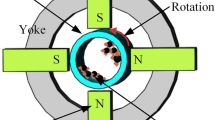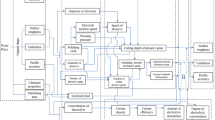Abstract
WC-Co cemented carbide (WC-Co) is widely used in micro/nano-manufacturing owing to its excellent chemical stability, high-temperature resistance, and stiffness. Yet, its significant hardness and wear resistance make machining a challenging endeavor. In response, this study explores electrochemical magnetorheological finishing (ECMRF), a method combining magnetorheological finishing (MRF) and electrochemical mechanical polishing (ECMP). ECMRF demonstrates an encouraging increase in material removal rate (MRR), achieving up to 92.0 nm/min, compared to the 16.7 nm/min of conventional MRF. This improvement is largely due to a surface loosening effect on WC, facilitated by an oxide layer from surface electrooxidation. Furthermore, ECMRF shows a potential to enhance the convergence of surface roughness (Sa), at a rate significantly faster than traditional MRF. Post-polishing analyses indicate the WC workpiece remains chemically intact, without surface or subsurface damage. The process effectively reduces the Sa from 87.2 to 2.1 nm. This pioneering research underscores the prospect in polishing challenging materials and presents an innovative route to achieve highly efficient surface polishing with nanoscale roughness.









Similar content being viewed by others
References
Asgar MA, Kim J, Haq MR, Kim T, Kim SM (2021) A comprehensive review of micro/nano precision glass molding molds and their fabrication methods. Micromachines (Basel) 12. https://doi.org/10.3390/mi12070812
Peng Y, Shen B, Wang Z, Yang P, Yang W, Bi G (2021) Review on polishing technology of small-scale aspheric optics. Int J Adv Manuf Technol 115:965–987. https://doi.org/10.1007/s00170-021-07202-3
Kumari A, Sankaranarayana M, Nandy TK (2017) On structure property correlation in high strength tungsten heavy alloys. Int J Refract Met Hard Mater 67:18–31. https://doi.org/10.1016/j.ijrmhm.2017.05.002
Xia Z, Fang F, Ahearne E, Tao M (2020) Advances in polishing of optical freeform surfaces: a review. J Mater Process Technol 286. https://doi.org/10.1016/j.jmatprotec.2020.116828
Huang H, Chen WK, Kuriyagawa T (2007) Profile error compensation approaches for parallel nanogrinding of aspherical mould inserts. Int J Mach Tools Manuf 47:2237–2245. https://doi.org/10.1016/j.ijmachtools.2007.06.008
Suzuki H, Moriwaki T, Yamamoto Y, Goto Y (2007) Precision cutting of aspherical ceramic molds with micro PCD milling tool. CIRP Ann-Manuf Technol 56:131–134. https://doi.org/10.1016/j.cirp.2007.05.033
Fang FZ, Chen YH, Zhang XD, Hu XT, Zhang GX (2011) Nanometric cutting of single crystal silicon surfaces modified by ion implantation. CIRP Ann-Manuf Technol 60:527–530. https://doi.org/10.1016/j.cirp.2011.03.057
Li C, Hu Y, Zhang F, Geng Y, Meng B (2023) Molecular dynamics simulation of laser assisted grinding of GaN crystals. Int J Mech Sci 239:107856. https://doi.org/10.1016/j.ijmecsci.2022.107856
Li C, Piao Y, Meng B, Hu Y, Li L, Zhang F (2022) Phase transition and plastic deformation mechanisms induced by self-rotating grinding of GaN single crystals. Int J Mach Tools Manuf 172:103827. https://doi.org/10.1016/j.ijmachtools.2021.103827
Yi AY, Jain A (2005) Compression molding of aspherical glass lenses–a combined experimental and numerical analysis. J Am Ceram Soc 88:579–586. https://doi.org/10.1111/j.1551-2916.2005.00137.x
Suzuki H, Hamada S, Okino T et al (2010) Ultraprecision finishing of micro-aspheric surface by ultrasonic two-axis vibration assisted polishing. CIRP Ann-Manuf Technol 59:347–350. https://doi.org/10.1016/j.cirp.2010.03.117
Yin SH, Xu ZQ, Yu JW, Wang ZB (2011) A polishing method of single-incentive ultrasonic elliptical vibration for tungsten carbide mould. Solid State Phenom 175:140–144. https://doi.org/10.4028/www.scientific.net/SSP.175.140
Beaucamp AT, Freeman RR, Matsumoto A, Namba Y (2011) Fluid jet and bonnet polishing of optical moulds for application from visible to x-ray. In: Proceedings Volume 8126, Optical Manufacturing and Testing IX; 81260U. https://doi.org/10.1117/12.905491
Kumar S, Tong Z, Jiang X (2022) Advances in the design and manufacturing of novel freeform optics. Int J Extreme Manuf 4. https://doi.org/10.1088/2631-7990/ac7617
Saraswathamma K (2013) Magnetorheological finishing: a review. Int J Curr Eng Technol 2:168–173. https://doi.org/10.14741/ijcet/spl.2.2014.30
Wang Y, Yin S, Hu T (2018) Ultra-precision finishing of optical mold by magnetorheological polishing using a cylindrical permanent magnet. Int J Adv Manuf Technol 97:3583–3594. https://doi.org/10.1007/s00170-018-2199-z
Xu Z, Wang J, Yin S, Wu H, Yi L (2021) Compound machining of tungsten alloy aspheric mould by oblique-axis grinding and magnetorheological polishing. Int J Precis Eng Manuf 22:1487–1496. https://doi.org/10.1007/s12541-021-00504-2
Li C, Bhat IB, Wang R, Seiler J (2004) Electro-chemical mechanical polishing of silicon carbide. J Electron Mater 33:481–486. https://doi.org/10.1007/s11664-004-0207-6
Lee S-J, Lee Y-M, Du M-F (2003) The polishing mechanism of electrochemical mechanical polishing technology. J Mater Process Technol 140:280–286. https://doi.org/10.1016/s0924-0136(03)00720-9
Murata J, Yodogawa K, Ban K (2017) Polishing-pad-free electrochemical mechanical polishing of single-crystalline SiC surfaces using polyurethane–CeO2 core–shell particles. Int J Mach Tools Manuf 114:1–7. https://doi.org/10.1016/j.ijmachtools.2016.11.007
Deng H, Zhang X, Liu K, Yamamura K, Sato H (2017) Polishing of tungsten carbide by combination of anodizing and silica slurry polishing. J Electrochem Soc 164:E352–E359. https://doi.org/10.1149/2.1931712jes
Jang K-I, Seok J, Min B-K, Jo Lee S (2010) An electrochemomechanical polishing process using magnetorheological fluid. Int J Mach Tools Manuf 50:869–881. https://doi.org/10.1016/j.ijmachtools.2010.06.004
Jang K-I, Nam E, Lee C-Y, Seok J, Min B-K (2013) Mechanism of synergetic material removal by electrochemomechanical magnetorheological polishing. Int J Mach Tools Manuf 70:88–92. https://doi.org/10.1016/j.ijmachtools.2013.03.011
Deng H, Hosoya K, Imanishi Y et al (2015) Electro-chemical mechanical polishing of single-crystal SiC using CeO2 slurry. Electrochem Commun 52:5–8. https://doi.org/10.1016/j.elecom.2015.01.002
Jiao L, Wu Y, Wang X, Guo H, Liang Z (2013) Fundamental performance of magnetic compound fluid (MCF) wheel in ultra-fine surface finishing of optical glass. Int J Mach Tools Manuf 75:109–118. https://doi.org/10.1016/j.ijmachtools.2013.09.00
Zhan D, Han L, Zhang J, Shi K, Zhou JZ, Tian ZW, Tian ZQ (2016) Confined chemical etching for electrochemical machining with nanoscale accuracy. Acc Chem Res 49:2596–2604. https://doi.org/10.1021/acs.accounts.6b00336
Han L, Zhao X, Hu Z, Zhang J, Cao Y, Yan Y, Tian Z-Q, Tian Z-W, Zhan D (2017) Tip current/positioning close-loop mode of scanning electrochemical microscopy for electrochemical micromachining. Electrochem Commun 82:117–120. https://doi.org/10.1016/j.elecom.2017.07.023
Han L, Hu Z, Sartin MM, Wang X, Zhao X, Cao Y, Yan Y, Zhan D, Tian ZQ (2020) Direct nanomachining on semiconductor wafer by scanning electrochemical microscopy. Angew Chem Int Ed 59:21129–21134. https://doi.org/10.1002/anie.202008697
ISO (2018) Metallic materials - Vickers hardness test - Part 1: Test method. (ISO 6507-1:2018). Geneva: International Organization for Standardization
Acknowledgements
We would like to thank Tan Kah Kee Innovation Laboratory for sample characterization.
Funding
This work was financially supported by the National Natural Science Foundation of China (22202166, 52075463, 21827802, 22132003, and 22021001), Technology Projects of Shenzhen (JCYJ20210324122001003), Hunan Province Key Research and Development Program (No. 2023GK2069), Fujian Province Science and Technology Plan Project (2021H6008), and the 111 Project (B08027, B17027).
Author information
Authors and Affiliations
Contributions
Jiaming Liu performed the research, analyzed data, and wrote the paper; Lianhuan Han, Shiyi Luo, and Yunfeng Peng designed the study and revised the manuscript; Xiaoting Lin performed the data processing; Huiming Feng helped with the experiment.
Corresponding author
Ethics declarations
Conflict of interest
The authors declare no competing interests.
Additional information
Publisher’s note
Springer Nature remains neutral with regard to jurisdictional claims in published maps and institutional affiliations.
Rights and permissions
Springer Nature or its licensor (e.g. a society or other partner) holds exclusive rights to this article under a publishing agreement with the author(s) or other rightsholder(s); author self-archiving of the accepted manuscript version of this article is solely governed by the terms of such publishing agreement and applicable law.
About this article
Cite this article
Liu, J., Han, L., Lin, X. et al. Electrochemical magnetorheological finishing for hard-to-machine functional materials with nanometer-scaled surface roughness. Int J Adv Manuf Technol 130, 4713–4722 (2024). https://doi.org/10.1007/s00170-023-12898-6
Received:
Accepted:
Published:
Issue Date:
DOI: https://doi.org/10.1007/s00170-023-12898-6




